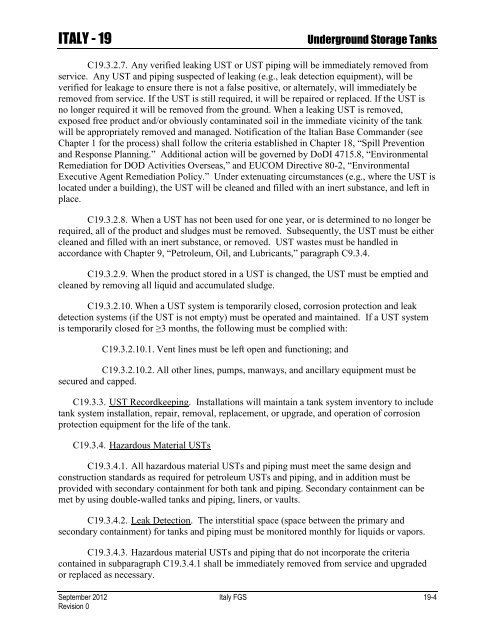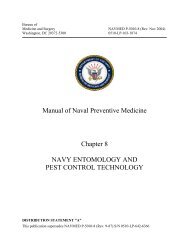ENVIRONMENTAL FINAL GOVERNING STANDARDS ITALY
ENVIRONMENTAL FINAL GOVERNING STANDARDS ITALY
ENVIRONMENTAL FINAL GOVERNING STANDARDS ITALY
You also want an ePaper? Increase the reach of your titles
YUMPU automatically turns print PDFs into web optimized ePapers that Google loves.
<strong>ITALY</strong> - 19 Underground Storage Tanks<br />
C19.3.2.7. Any verified leaking UST or UST piping will be immediately removed from<br />
service. Any UST and piping suspected of leaking (e.g., leak detection equipment), will be<br />
verified for leakage to ensure there is not a false positive, or alternately, will immediately be<br />
removed from service. If the UST is still required, it will be repaired or replaced. If the UST is<br />
no longer required it will be removed from the ground. When a leaking UST is removed,<br />
exposed free product and/or obviously contaminated soil in the immediate vicinity of the tank<br />
will be appropriately removed and managed. Notification of the Italian Base Commander (see<br />
Chapter 1 for the process) shall follow the criteria established in Chapter 18, “Spill Prevention<br />
and Response Planning.” Additional action will be governed by DoDI 4715.8, “Environmental<br />
Remediation for DOD Activities Overseas,” and EUCOM Directive 80-2, “Environmental<br />
Executive Agent Remediation Policy.” Under extenuating circumstances (e.g., where the UST is<br />
located under a building), the UST will be cleaned and filled with an inert substance, and left in<br />
place.<br />
C19.3.2.8. When a UST has not been used for one year, or is determined to no longer be<br />
required, all of the product and sludges must be removed. Subsequently, the UST must be either<br />
cleaned and filled with an inert substance, or removed. UST wastes must be handled in<br />
accordance with Chapter 9, “Petroleum, Oil, and Lubricants,” paragraph C9.3.4.<br />
C19.3.2.9. When the product stored in a UST is changed, the UST must be emptied and<br />
cleaned by removing all liquid and accumulated sludge.<br />
C19.3.2.10. When a UST system is temporarily closed, corrosion protection and leak<br />
detection systems (if the UST is not empty) must be operated and maintained. If a UST system<br />
is temporarily closed for ≥3 months, the following must be complied with:<br />
C19.3.2.10.1. Vent lines must be left open and functioning; and<br />
C19.3.2.10.2. All other lines, pumps, manways, and ancillary equipment must be<br />
secured and capped.<br />
C19.3.3. UST Recordkeeping. Installations will maintain a tank system inventory to include<br />
tank system installation, repair, removal, replacement, or upgrade, and operation of corrosion<br />
protection equipment for the life of the tank.<br />
C19.3.4. Hazardous Material USTs<br />
C19.3.4.1. All hazardous material USTs and piping must meet the same design and<br />
construction standards as required for petroleum USTs and piping, and in addition must be<br />
provided with secondary containment for both tank and piping. Secondary containment can be<br />
met by using double-walled tanks and piping, liners, or vaults.<br />
C19.3.4.2. Leak Detection. The interstitial space (space between the primary and<br />
secondary containment) for tanks and piping must be monitored monthly for liquids or vapors.<br />
C19.3.4.3. Hazardous material USTs and piping that do not incorporate the criteria<br />
contained in subparagraph C19.3.4.1 shall be immediately removed from service and upgraded<br />
or replaced as necessary.<br />
September 2012 Italy FGS 19-4<br />
Revision 0
















